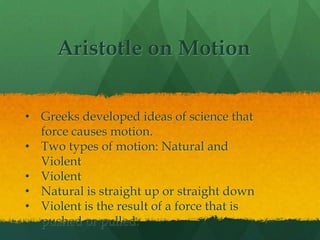
Physics chapter 3 2012
- 1. Aristotle on Motion • Greeks developed ideas of science that force causes motion. • Two types of motion: Natural and Violent • Violent • Natural is straight up or straight down • Violent is the result of a force that is pushed or pulled.
- 2. Copernicus and the Moving Earth Determined that the simplest way to interpret astronomical observations was to assume Earth and other planets move around the sun. Most believed that the Earth was at the center of the universe not the sun. Copernicus was prosecuted for his thoughts.
- 3. Galileo on Motion Italian scientist Supported Copernicus ideas. Did not believe that force is necessary to keep an object moving. Friction: The name of force where two materials touch as they move past each other. Concluded that two inclined planes facing each other will roll a ball back and forth. Inertia=the property of a body to resist changes to its state of motion.
- 4. Newton’s Law of Inertia Changed the Aristotelian ideas that had dominated for 2000 years. Developed famous laws of motion. Law of Inertia=restatement of Galileo’s idea that a force is not needed to keep an object moving. Every object continues in a state of rest, or uniform speed in a straight line, unless acted on by a nonzero net force.
- 5. Objects at Rest Things that tend to keep on doing what they are already doing. Dishes on a tabletop are in a state of rest. Only a force will change their state of rest. Dishes moving if a tablecloth is ripped out from under them.
- 6. Objects in Motion When there is more friction, the object has less of a chance to move. A hockey puck hit on the street will move less than one hit on ice or an air hockey table. An object tossed in space will move forever by virtue of its own inertia. Ancients thought that continual forces were needed to maintain motion. Objects continue to move by themselves.
- 7. Isaac Newton At 24 years old he laid the foundations for physics. Established himself as a first rate mathematician. Elected to the Royal Society, where he exhibited the world’s first reflector telescope and made with his own hands. Wrote one of the greatest scientific books ever written, the Principia Mathematica Philosophiae Naturalis. Elected into Parliament Knighted by Queen Anne and buried at Westminster Abbey. His ideas and insights changed the world and elevated the human condition.
- 8. Mass-A Measure of Inertia • The more mass an object has, the greater its inertia and the more force it takes to change its state of motion. • Kick an empty soda can it goes a distance. • Kick a soda can filled with sand and it won’t go as far. • The amount of inertia an object has depends on its mass-the amount of material in the object.
- 9. Mass is not Volume Do not confuse mass and volume Volume is a measure of space and is measured in units. Mass is measured in the unit of kilograms. An equal size bag of cotton balls and nails have equal volumes but not equal mass.
- 10. Mass is Not Weight Mass is often confused with weight. Mass is a measure of the amount of material in an object and depends only on the number of and kind of atoms that compose it. Weight is a measure of the gravitational force acting on the object
- 11. Mass is Inertia The amount of material in a stone is the same no matter on earth, space or the moon. The weight of the stone would be very different on earth, the moon or space. Mass is the quantity of matter in an object. Weight is the force of gravity on an object.
- 12. One Kilogram Weighs 10 Newtons In the US it is common to describe matter in an object by its weight. In most other parts of the world it is common to describe matter in units of mass. SI is the unit of mass. The SI unit of force is the newton. Weight and mass are proportional to each other.
- 13. Objects Move With Earth The law of inertia states that objects in motion remain in motion if no unbalanced forces act on them. All objects move as the earth does too. If you are jumping off a step to go straight down to pick up a ball, all objects are moving at the same time, so you are able to go straight down and nothing.
- 14. Objects Move With Vehicles The vertical force of gravity affects only the vertical motion of a coin. If you flip a coin while in a fast traveling car, train or plane the coin will keep up with us because of the law of inertia. Aristotle did not recognize the idea of inertia. He imagined that there were different laws for motion on earth and in space. Galileo and Newton thought the same rules for all moving objects requiring no force to keep moving if friction was not present.